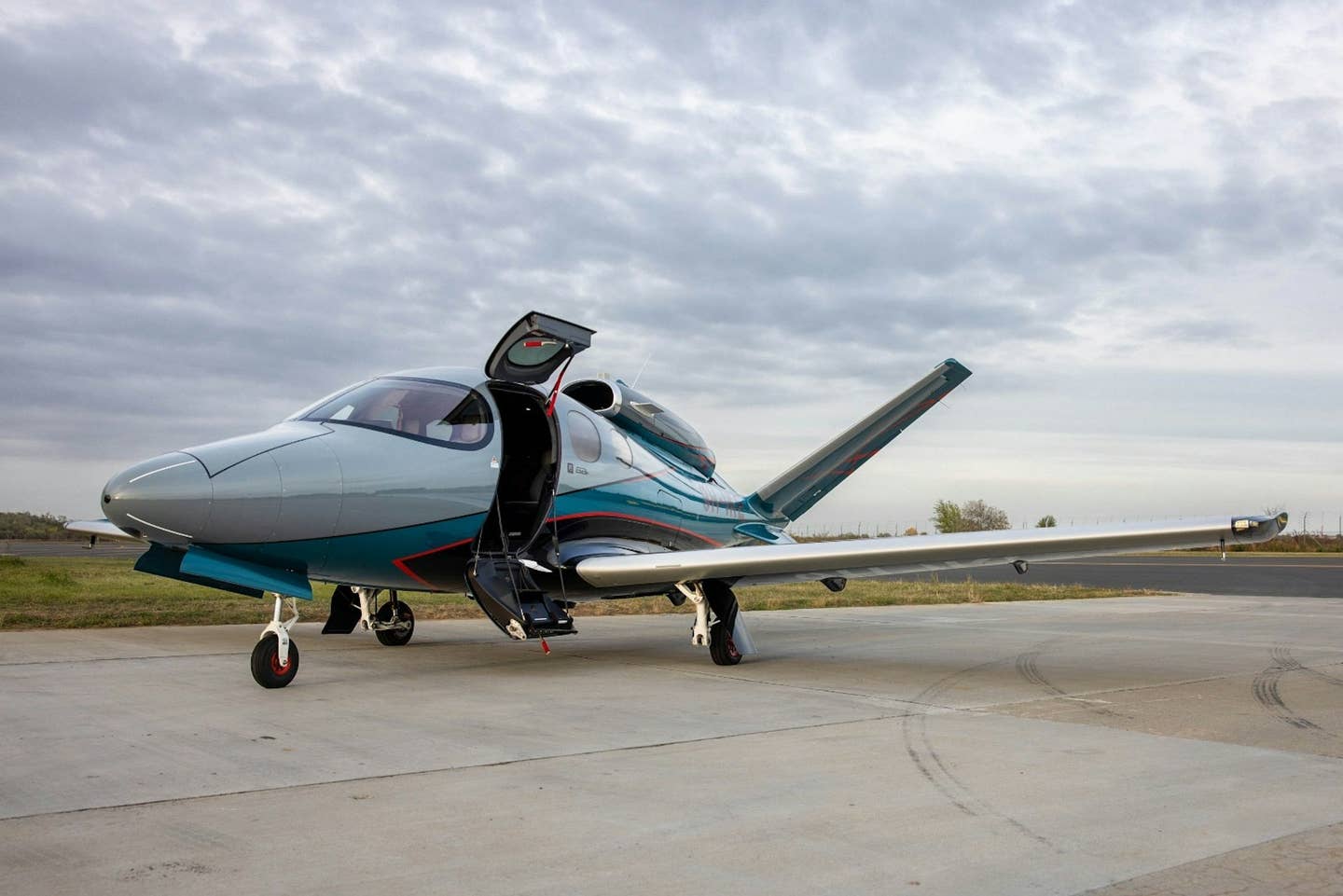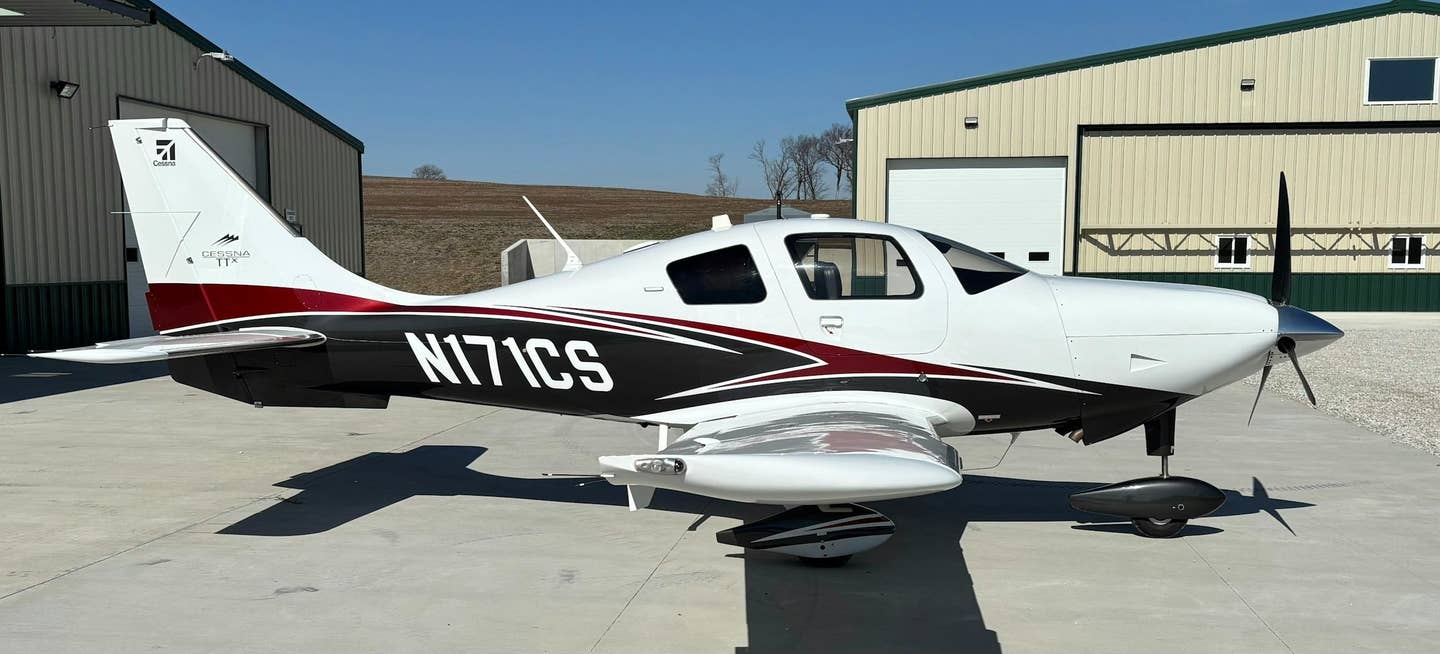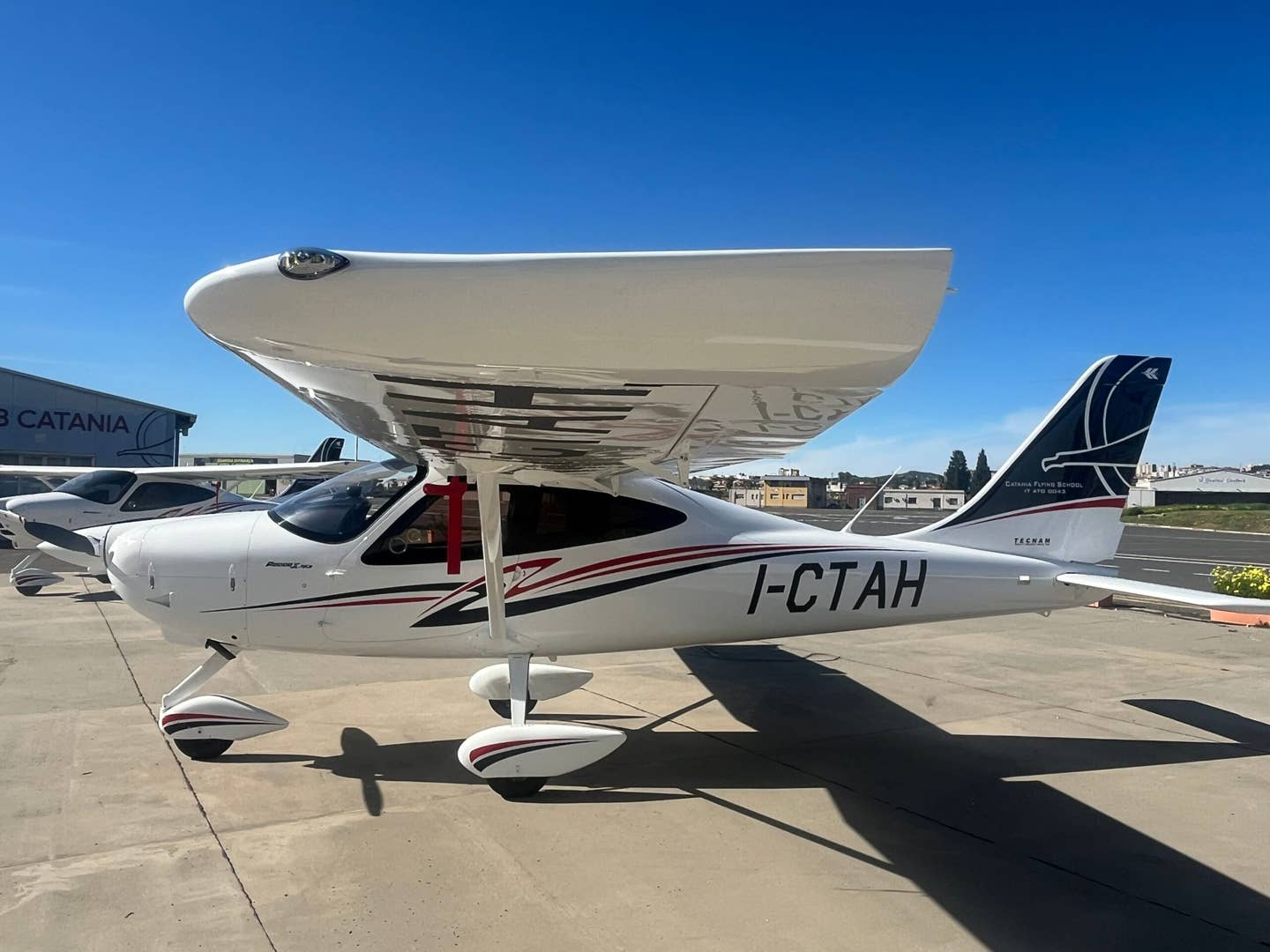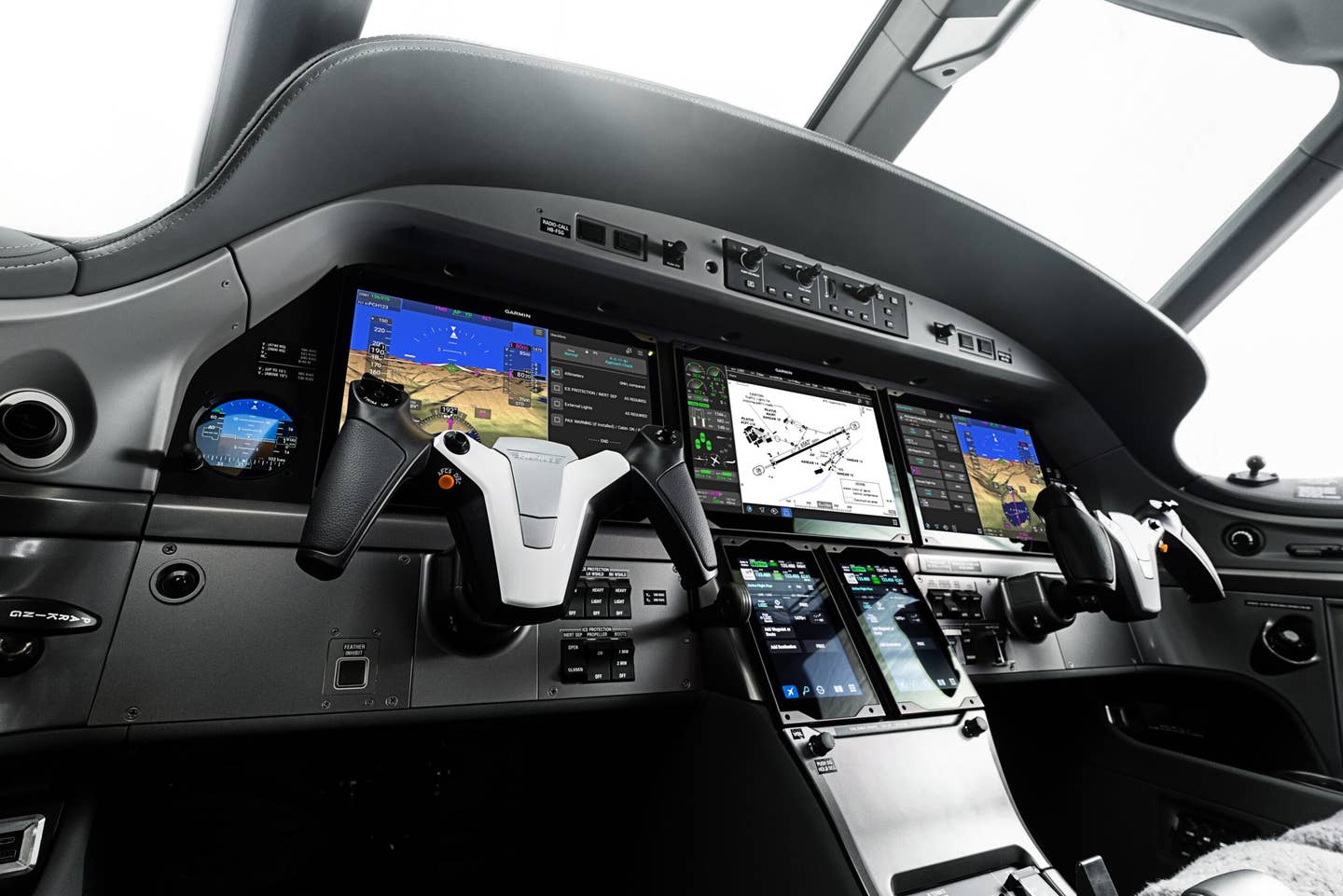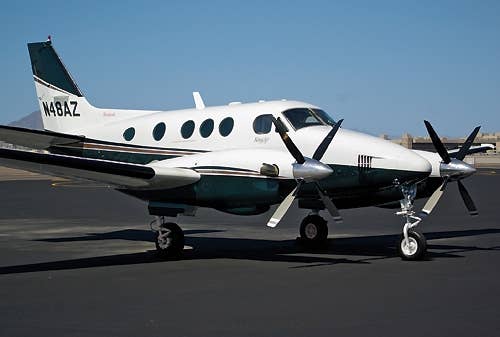
Refurbished 1979 King Air C90 Robert Goyer
New King Airs are wonderful airplanes, but they do cost what new airplanes of that caliber cost. As with any new model, a factory-fresh King Air gives you a lot of things you can't retrofit affordably, if at all, into a 20- or 30-year-old airplane. That's why people keep buying new King Airs.
While there are a lot of mods available for older King Airs, the end result is not going to be an airplane that's as good as a new one -- as much as you might wish that to be true. What you can get is one that is, without question, better than it was back when it was new.
That is, indeed, exactly the case for N48AZ, the 1979 King Air C90 I met out in Phoenix recently, an airplane that Cutter Aviation extensively refurbished, showing just how far a reasonable investment could go toward making a long-in-the-tooth airplane a desirable commodity once again.
Now, a good-sized volume could be written about the history of the King Air line, but here's the short story on the C90. Beech launched into King Air development in the early 1960s, and by the middle of the decade, the precursor of the C90 was being delivered to customers. The King Air, then and now, offered an unparalleled combination of cabin size, low operating costs, short and rough field capabilities, load carrying might and reasonable speed. You know the rest of the story. The King Air is the most successful turboprop in history, and its sales continue strong to this day.
The C90 in particular was a great seller for Beech. Introduced in 1971, the C90 had the upgraded Pratt & Whitney PT6A-20A engines and a significantly longer wingspan than earlier models. These changes combined to allow an increase in maximum takeoff weight of 350 pounds, to 9,650 pounds. Over the roughly dozen years it built the C90, Beech delivered more than 500 of them (and more than 50 C90-1s, a nearly identical model that was built until the early '80s). The C90 wasn't the swiftest turboprop in the skies, but it was apparently fast enough to every year outsell its speedier competition, which, by the way, hasn't been around for the last few decades.
The King Air is also a famously rugged airplane, and that means there are still a lot of those roughly 550 C90s out there. And in today's used aircraft market, there are some great values to be had in older C90s with a lot of life left in them. And those King Airs can be had at a good cost, well less than half a million dollars for an airplane in good shape but needing engines.
This story is about one of those airplanes.
The Cutter Way
Cutter Aviation has been in the FBO business -- and all the sub-businesses that that implies -- for longer than just about anybody. And as a family-owned business, a rarity in the FBO world today, it has a different, more hands-on feel than many of its competitors. While the Cutter name might be familiar to you, you might not know the story behind this historic FBO.
Cutter was founded by William P. Cutter as Cutter Flying Service in 1928 in Albuquerque (just a couple of months after Flying got its start). Cutter somehow survived the Great Depression, and when World War II started, it became a major military pilot training center. In 1947 it became a Beech dealer, an association that lasted more than 60 years, until just earlier this year when Hawker Beechcraft started selling its airplanes direct. Today, in addition to its KABQ location, Cutter has a number of FBOs and maintenance centers in the West, including its facilities at Sky Harbor in Phoenix (KPHX) and nearby Deer Valley (KDVT); and also in Dallas (KRBD), El Paso, McKinney and San Antonio, Texas, as well as a new location in Colorado Springs.
In terms of services, it's not so much a question of what Cutter offers as what it doesn't. At various locations, it offers its customers full-service fueling, tie-downs and hangars, maintenance and avionics installation and repair, aircraft sales and charter.
And it's still family run today, with William P. Cutter's son Bill Cutter serving as chairman of the board and his son, Will Cutter, as president.
Trash or Treasure?
Typically, when an airplane sales company comes into possession of an airplane, it's through a trade. That was not the case with 48AZ. Cutter had done some work on it for a customer years ago, putting in a good number of avionics upgrades, including a new Stormscope. But when it came time to pay, the folks at Cutter told me, the owner, despite the best efforts of all concerned to track him down, was nowhere to be found. Cutter was left with an older airplane with runout engines sitting on the ramp with no one to get it out of hock. And there it sat for several years with a mechanic's lien and a prop lock, getting dusty but not rusty -- you've got to love Arizona airplanes.
Just last year Cutter decided to do something with the old King Air, and settled on making a refurbishment demonstrator out of it, using it to show prospects just what it could do with some investment and a little time.
Cutter bought the airplane at auction -- it was the only creditor and the only bidder -- and went to work at making it shine again. The whole project, and it was an extensive one, took just 30 days.
** C90 Transformed: A Team Effort**
The trick to making a successful refurbishment of a lower-value existing airplane is to not overdo it, and in this case, it seems to me Cutter made all the right moves. Since Cutter was creating a demonstrator airplane, even if they had spent more than they would get out of the airplane when the time came to sell it, that would just be part of the investment.
But that's not at all how it turned out.
When it came time to plan the project, just about everything except the basic airframe needed addressing. Paint and interior were absolute musts, the engines needed replacement, and the avionics could use an upgrade, too. And in making sweeping improvements to the airplane Cutter employed a number of partners from around the country.
In terms of paint and interior, the results speak for themselves. When passengers climb aboard the airplane, many of them, I'm told, think they're getting into a new airplane, not a 30-year-old one. Cutter had a local shop, Jetcrafters Worldwide, out of Safford, Arizona, do the paint, and, as you can see, it looks terrific. Another neighbor, Arizona Aircraft Interiors, located at Falcon Field in Mesa, near Phoenix, did the interior refurbishment, which, again, was very nicely executed.
And there's a lot to work with. The C90 has six seats in back. It's a roomy and comfortable interior, and one that benefits from the presence of an aft belted potty seat, a pair of folding work tables, entertainment plugs and polarizing window conceals.
New Engines … and Much More
There are certain upgrades that do nice things for King Airs on their own, but Raisbeck has effectively multiplied their benefits by combining them in a bundle it calls the Raisbeck C90 Epic package.
The central element is the Blackhawk-135A engine upgrade. The Pratt & Whitney 135A engine is an improved model that is essentially plug and play compatible with the original engines, provides better performance, capability and utility -- more on exactly what that means in a bit -- and quieter operation when paired with the Quiet Turbofan props. And it does it at a price that is comparable to overhaul. When you factor in the core exchange, the new engine warranty and a new flight manual supplement (as part of the Raisbeck package), you can see why the Blackhawk engines have been a success story. While they don't add any nominal power -- they're rated at 550 shp, like the originals -- they do run a lot cooler, allowing higher ITT, from 700 degrees on the Dash-21 engines previously installed on the airplane all the way up to 800 degrees. The higher temperature limitation gives better performance -- more power, better speeds and greater rate of climb, especially at altitude.
Going hand in hand with the new engines are the new props, which Raisbeck designed in conjunction with Hartzell for this application. The Quiet Turbofan Propellers system adds a lot to the package, and the prop design is unusual in a few different ways, all of them good. For one, it features oddly squared-off tips that greatly reduce high-frequency prop noise. There's more twist to the blades, and the prop's airfoil is longer, too, resulting in improved performance and lower noise. Because the propeller airfoil shape runs all the way into the hub, it produces more airflow into the engine, for more effective cooling. This helps keep temps down, which in the turbine world equates directly with improved performance, as many limitations are temperature based.
The final part of the Epic package is the Dual Aft Body Strake mod, which gives the airplane greater directional stability to improve its basic handling. At the same time the strakes allow the max weight to increase by improving handling at the higher weight.
That higher max takeoff weight is an impressive 10,500 pounds, an increase of 850 pounds over the stock C90 with no additional, structural mods required. That's a remarkable upgrade in terms of utility.
The additional load-carrying capacity makes the next, optional mod a natural: wing lockers. Raisbeck's Crown Wing Locker System is a modification to the rear engine nacelle that gives the operator 600 pounds total of additional storage (300 a side) while allowing convenience and flexibility in loading. Typically, pilots of Crown Wing Locker-equipped airplanes will put their own gear in the right side locker and the passengers' in the left locker. When they arrive at the destination, the pilot opens the airstair door, climbs down, opens the locker, and the passengers' bags are right there for them. Afterward, the pilots can get their own bags from the other side, or leave them and launch on the next leg. The lockers are big enough for several sets of travel golf clubs, fly-fishing poles or hunting rifles, all bulky items you don't necessarily want to keep in the cabin anyway.
Proof
The claims that Raisbeck makes for its Epic package are impressive, and they're true. I flew with Cutter Chief Pilot PJ Proxee in the C90 out of Sky Harbor. Our hour-long trip took us down to Tucson and up to 20,000 feet, where we were seeing a true airspeed of around 255 knots while burning 265 pounds per hour per side. At 25,000 feet, the modified airplane will do 265 knots true while burning around 260 pounds per hour. All of these figures are big improvements over the original C90. In terms of true airspeed, it's an improvement of better than 60 knots.
Another benefit is in takeoff length. With the Epic mods the C90 can operate out of fields hundreds of feet shorter than its nonmodified predecessor can, opening up a lot of additional airports around the country. And though I didn't have a nonmodified C90 to compare it to, the airplane we flew did seem remarkably smooth and quiet, which was exactly the experience Raisbeck and Blackhawk said I'd have. In that regard, I had to remind myself that it was a 30-year-old airplane I was in.
On the Gauges: G600 Fits the Bill
When Cutter refurbished its C90, it was left with a hard choice. The airplane had a respectable panel already and a decent autopilot. But because Cutter wanted to use the airplane to demo its most popular retrofit brand, Garmin, it decided to replace the existing system with a Garmin panel.
The problem was that the obvious choice, G1000, isn't an option on the straight C90, only on the C90A (the successor to the C90) and later models. In this case, fortunately, the alternative was, again, Garmin, in the form of the G600.
And the G600 makes a lot of sense in this application. With the cost of full-sized (10-inch and larger) flat-panel systems starting at around $250,000, the owners of lower-value cabin-class airplanes often have a hard time justifying a new system that, despite the glitter, won't improve the airplane's ability to go anywhere or do anything. And today with used prices down across the board, the upgrade cost represents a sizable ratio of the value of an existing airplane.
When it introduced its G600 retrofit flat-panel system last year, Garmin was looking for it to find a home in a wide variety of airplanes from your garden-variety singles up through some cabin-class airplanes.
Cutter has been kept pretty busy with G600 installs. It will start work on its 16th and 17th G600 installations any day now. And while many of those projects have been on nice piston-powered airplanes, including a few Barons and Bonanzas, Cutter has installed G600 in a number of pressurized airplanes, from Malibus through King Airs.
I was a little surprised by this up-market appeal, but when I asked Gary Kelly, Garmin's director of sales and marketing, about it, he wasn't surprised at all. He pointed to the G600's feature set and scalability -- you can use either one or two displays, which will integrate with a large number of other systems -- as big selling factors to owners of larger airplanes, and he said that he felt that G600 was a particularly "great value proposition" for C90 owners, as it gave them great flexibility at a great price.
The G600 installation by Cutter in the C90 I checked out was impressive, and it's fair to say that it does transform the cockpit. The package includes a pair of G600 displays (each with its own PFD and MFD and with independent ADHRS and air data computers), a pair of Garmin GNS 430 navcom MFDs, a pair of Garmin GTX 330 Mode S transponders and a Garmin GMA 347 audio panel. In an airplane with an existing autopilot and radar, the cost of the package would be in the neighborhood of $130,000. But the addition of a new autopilot (the full-featured S-Tec Model 65 autopilot with GPSS and altitude preselect) and weather radar pushed the price on this project north of $200,000.
By the same token, on an older King Air that already had an autopilot and radar, a pilot-side-only G600 installation with dual 430s, Mode S transponder and more, would come in at around $70,000.
The features the G600 brings to the table belie its low asking price. You get aforementioned dual ADHRS and air data, autopilot and flight director interface, a full-featured moving map MFD with terrain, traffic and XM Weather, and much more. And for single-pilot operation, there's a lot of ease of use and situational awareness you get as part of the deal. The G600, simply said, is an excellent fit in the C90 panel in terms of aesthetics, function and economics.
Gone Before It Got There
As I said, Cutter put together this beautiful C90 to demonstrate its various retrofit programs to prospective customers.
Unfortunately, it did its job a little too well. A customer who was looking at a different King Air at the time spotted this C90 in the process of being refurbished and had to have it. Cutter, understandably, didn't want to part with it. As these things so often happen, the impasse came to a resolution when a convincing number was introduced into the discussions. And a very nicely outfitted King Air C90 found a new home.
Cutter isn't disclosing how much the airplane sold for, but I do know that a comparable King Air outfitted just like it would go for around $1.5 million. And remember, that's for an airplane with new paint, interior, glass in the panel and a decent autopilot, boots, color radar and even a little satellite entertainment for the folks in back. Oh, and did I mention the airstair door and the good-sized cabin?
This C90 project showed me that Cutter, with its 81 years of experience in aviation, knows its way around a refurb project. And it knows enough to work with some of the best mod houses in the industry, too. With Raisbeck's ingenious mods, Blackhawk's upgraded engines and Garmin's powerful and elegant retrofit avionics, Cutter has given new life to a great airframe that was almost left for dead. By the time it got done with it, the result was a C90 that is better in just about every respect than the airplane that rolled off the factory floor 30 years ago. And for a King Air, that is saying a lot.

Sign-up for newsletters & special offers!
Get the latest FLYING stories & special offers delivered directly to your inbox

